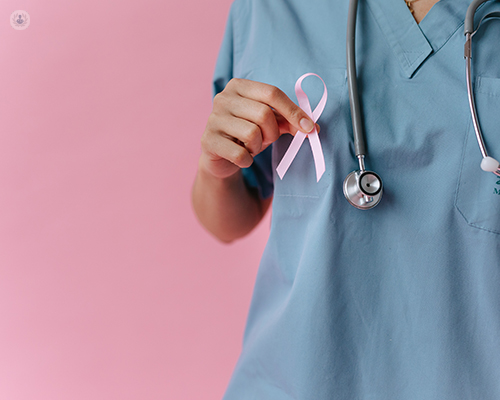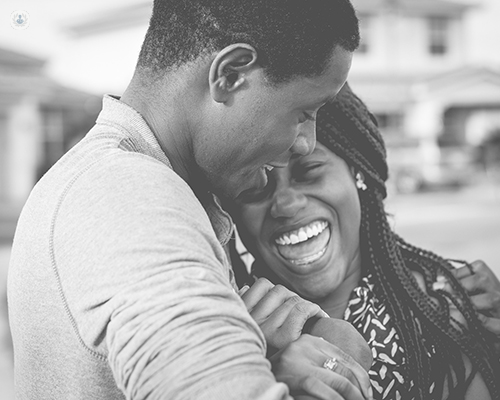An in-depth guide to breast lumps | Top Doctors
Escrito por:Breast cancer is the most common cancer in British women, with about 55,000 cases diagnosed every year. One of the first signs of breast cancer is a lump in the breast. In his latest article, renowned oncoplastic breast surgeon Mr Sumohan Chatterjee explains breast cancer and lumps in detail, including their causes, detection and diagnosis.

What are the most common causes of breast lumps?
The cause of breast lumps depends on the age of the patient. The younger the patient is, the lumps are more likely to b harmless. As they get older, it is more likely to be cancer. If the patient is over 50, most lumps are assumed to be cancers. If the patient is below 40, the most common breast lump is a fibroadenoma. This is not a true tumour. It is a collection of tissues within the breast under the influence of hormones, mainly oestrogen, which coalesces together and forms a lump.
Above 40, harmless lumps are more likely to be cysts. Cysts are filled with fluid and have a thin outer layer. Cysts continue until menopause is complete. They are very rare after menopause unless the patient Is on hormone replacement therapy.
All lumps should be subjected to a triple assessment:
- A detailed history.
- Imaging.
- Biopsy.
Depending on the age different scans are used:
- Below the age of 40, only ultrasound scans are used, as the breast is very dense and a mammogram will not be accurate.
- Beyond 40, a combination of mammogram and ultrasound is used.
When these scans have been done, we need to assess what the next course of action is.

If it is a cyst, we insert a needle and drain it. We assess the fluid, and if it is not blood-stained, it does not need further assessment. However, if it is blood-stained or the cysts do not completely collapse, a biopsy is needed. This is because certain cancers can grow inside a cyst, though this is rare.
If it is a solid lump, a biopsy is needed. We generally do not do a biopsy on a fibroadenoma on a patient under the age of 25, unless there is a clinical worry or it is not an obvious fibroadenoma on the ultrasound scan.
If the patient is above the age of 25, no matter how harmless the lump looks, it needs a biopsy. Most of the biopsies are done as cold biopsies. This involves using a bigger needle loaded onto a spring-loaded device, which removes tissues. This is a more accurate assessment than the past method of fine needle cytology. This involved using a standard needle and syringe. This removed cells which would then be sent for analysis. This method is not as accurate.
When we get a result back, usually after a week, we discuss it in a multi-disciplinary meeting. The surgeon, pathologist and radiology team will be present. If all three parts of the assessment indicate the lump is harmless, or it is cancerous, we proceed to the next stage. If the tissue is different to what we expected to find, an assessment needs to be made on whether or not we can trust that result. The biopsy may need to be repeated.
If it is a fibroadenoma, it is harmless and does not need to be removed unless it is above 4cm or it has grown rapidly.
Smaller fibroadenomas are mostly left alone, as only one-third of them get bigger. There is a new way to remove them, a vacuum-assisted excision. A very tiny cut is made and the lump is removed with the help of suction.
If the biopsy confirms it is cancerous, we then plan the treatment.
If we thought it was cancer before the biopsy, but the results come back negative, the biopsy is repeated in case something was missed.
If it is cancer, the armpit glands also need to be assessed. If they are abnormal (thickened) they also have to undergo biopsy, as this is the first place cancer will spread to outside the breasts. This will also decide what type of treatment will be needed.

Can breast lumps be benign (non-cancerous)?
Yes, breast lumps can be benign. The likelihood of this depends on the age of the patient and how the lump feels. Traditionally, we described breast lumps into three categories:
Fibroadenoma: most common in women younger than 40 years of age. They are very mobile and are rubbery, and soft but firm.
Cyst: Feels like a water-filled balloon. When you press it, it goes in but then returns to its original shape when released. It can feel harder if there is a lot of fluid.
Cancer: Usually stony hard, and it is not mobile at all. The edges are irregular.
The accuracy of clinical examination for lumps is about 75%. It is the triple assessment which gives us 99% certainty to classify the lump.
Can I feel a breast lump during a self-exam and when should I be concerned?
Breast self-examination is a very important tool, and is part of what we advocate as part of being breast aware. Every individual has a very different feel. Some breasts can feel different if the patient loses weight, or at different points in the menstrual cycle. There are very good websites such as Breast Cancer Now and Prevent which have very good teaching tools and videos that allow women to learn how to self-examine themselves properly.
We usually tell women to examine themselves once a month, in the middle of their cycle. You should do it in front of a mirror in a well-lit room. There are five zones in the breast: the four quadrants, and behind the nipple. You should use the flat of your hand to examine all the parts. If you use your fingertips, you can find lots of lumps that do not matter.
Any lump that you feel which is new to you or persists needs to be assessed by the medical fraternity. This usually starts with your GP. If he thinks there may be a problem he will send you to the one-stop breast clinic. The majority of patients who come to the one-stop breast clinic can be discharged and reassured that they are fine.
Mr Sumohan Chatterjee is a leading oncoplastic breast surgeon based in Greater Manchester and Wilmslow. If you would like to book a consultation with Mr Chatterjee you can do so today via his Top Doctors profile.


